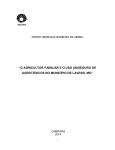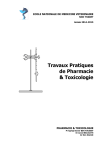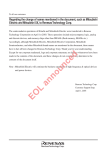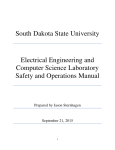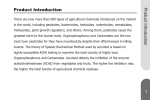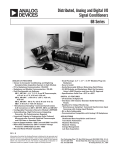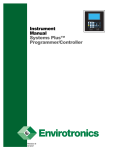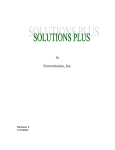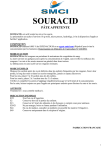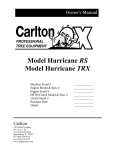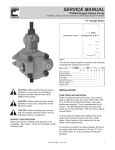Download USER`S MANUAL
Transcript
Sound Management of Pesticides and Diagnosis and Treatment of Pesticide Poisoning USER’S MANUAL Contents of the User’s Manual Objectives of the resource tool Computer system requirements How to start Contents of the Resource Tool Modules, subjects and sections - How to use the Resource Tool Where to find what information Target groups and training levels How to design and customize a training programme for a particular target group Preparing PowerPoint presentations Explanations on some of the functionalities of the resource tool, and problem solving How to order copies of the CD and the user’s manual Feed-back Annexes: Examples of training programmes; trainer’s “roadmap”; Subject Index Objectives of the Resource Tool This Resource Tool contains information on pesticides and their mode of action, personal protection measures as well as measures to protect the general public and the environment. The tool contains information on different aspects of pesticide management, in particular its judicious and safe application within the context of Integrated Pest and Vector Management. The tool also provides information on diagnosis, first aid and treatment of pesticide poisonings. The Resource Tool is intended for use in national programmes to assist in management of pesticides, and provide aid in diagnosis and treatment of pesticide poisoning, for use in formulating training courses, and may be adapted to the specific needs of different target groups. Computer System Requirements To run the Compact Disc the following (minimum) computer system requirements are recommended: • • • • Microsoft Windows 98 or later 128 megabyte Random Access Memory (RAM) Quad speed (4X) CD-ROM drive Internet Explorer 5 or later This CD is optimised to run under Windows 98/ME/NT/2000/XP/Vista using Macromedia Flash. For the reading materials included, you need Flip Viewer 2.2 or greater (from FlipViewer.com) and Acrobat Reader 5 or greater (from Adobe.com) to view them. Flip Viewer and Acrobat Reader can be installed either by downloading from the Internet at http://www.flipviewer.com/ and http://www.adobe.com/, or running the Set-up program from the CD-ROM. How to Start - Contents of the Compact Disc 1. 2. 3. 4. 5. 6. Insert the CD-ROM. The screen shown in Figure 1 should open automatically. If it does not: Double-click the My Computer icon on your Windows desktop. Go to the CD and double-click on the Main.exe file. The screen should now look like Picture 1 below. The resource tool will now be ready for use. Picture 1- Entrance to the resource tool Select and click on either Macromedia Flash for interactive mode or the pdf format. If you select Macromedia Flash you will now arrive at the Preface section with Contents in the sidebar. From here you can go to any other section of the resource tool. Picture 2 – Contents and Preface (page 1 of 3) Contents of the Resource Tool The Resource tool comprises two main parts and Annexes: Preface Acknowledgements Part I: Overview, which contains 4 subtitles: • Introduction • Overview of the resource tool: Module description, Training levels (explained below), Visual aids, and Information sources • Using the resource tool: Introduction, Training trainers, Trainers • Index of subjects covered by modules Part II: The Modules contains the following ten modules: 1. General considerations 2. Absorption and effects of pesticides 3. Personal protection 4. Protecting the environment and the general public (see Picture 6) 5. Chemical groups and modes of action of pesticides 6. First aid for pesticide poisoning 7. Medical treatment of pesticide poisoning 8. Administrative work and scientific subjects 9. Course evaluation methodology 10. Documentation (The pesticides CD-ROM) Picture 3 – Module 4: Protecting the environment and the general public (page 1 of 2) Picture 3 shows the contents seen when clicking on Module 4 in Part II. This Module has six Subjects, A-F (click on the page 2 button to find out about Subjects E and F). To continue, select Subject C. Picture 4 – Integrated pest and vector management, Subject C of Module 4 (page 1 of 4) Picture 4 shows Subject C of Module 4: Integrated pest and vector management. Educational objectives for each training level will be found at the right hand side of the screen. Select and click to learn more. The text on the screen constitutes a part of the Main Points of Subject C. Click on page buttons at the bottom right of the screen to continue to pages 2, 3 and 4. Buttons at the bottom left of the page allow you to switch to Subsidiary points (plus sign), Discussion points (people symbol) or Training notes (note pad). Some Subjects may have a video clip (video camera). Click on the ‘MP’ button to return to the Main Points Annex I: Glossary Annex I contains a Glossary of words frequently used in the modules. An excerpt is shown in Picture 5. Picture 5 – Appendix I - Glossary Annex II: Other sources of information, which contains: • • • • • • • • Preventing Health Risk From the Use of Pesticides in Agriculture Instruction for Treatment and Use of Insecticide-treated Mosquito Nets International Code of Conduct on the Distribution and Use of Pesticides The WHO Recommended Classification of Pesticides by Hazard Pesticide Training Tool Kit - A guide for community workers Management of Poisoning - A handbook for health care workers PowerPoint Presentation Templates Links to other sites Annex III: Image archive, which contains • • • • Images FAO/GIFAP/CropLife Pictograms GHS Pictograms Videos Annex 7 of this User’s Manual contains an index of where to find information within the resource tool. Within the tool, Part I: Overview, Section 4 also contains an index of subjects. Modules, Subjects and Sections – How to Use the Resource Tool Under each Module in Part II there are Subjects (alphabetical) and Sections (numerical). Annex 4 of this User’s Manual shows an example of a 1-week training programme for spray men in agriculture and their supervisors, jointly or separately. The first day of this programme will cover a total of nine training Sections (1A1, 1A6, 1B3, 1C1, 2A1, 2A2, 2A3, 2A4 and 2B1). With the help of an appropriate projector (beamer), the entire contents of the Resource Tool can be projected on a white screen. In this case, the Trainer must be well prepared to avoid losing time while searching for sections to follow in his presentations. Annex 6 gives an example of how to prepare a roadmap for a training session on chemical groups of pesticides, their mode of action, first aid and medical treatment of poisonings. The relevant sections belong to either the Intermediate or the Advanced level of training. However, a Trainer may want to or may have to go from one Module to another during a particular training session. A roadmap of this kind will facilitate the navigation between modules and sections. Target Groups and Training Levels The toolbox has been created for a wide range of training needs including pesticide users, policy makers, regulators, distributors, non-governmental organizations, educators, health care providers and the general public. The primary users of the toolbox however, are designated trainers set out to train others. The contents of each Module are presented at three levels to allow trainers to design courses suitable for target groups with different educational background and training needs: • Basic: Covers fundamental issues such as personal protection and general information on risks of exposure and environmental contamination. • Intermediate: More detailed, for participants with supervisory or operational responsibilities, who may work with more hazardous compounds and need a better understanding of preventive measures • Advanced: For participants engaged in the regulation and control of pesticides and management of poisonings The Resource Tool contains a total of over 220 sections of which approximately 60 are of the category Basic, 100 Intermediate and 60 Advanced. The emphasis throughout should be the relevance of the material to the group being trained. The participants should have some characteristics in common, such as occupation or interest, and should have a similar educational background. The following sections show examples of target groups in public health and agriculture. The latter case, in turn, illustrates an option for a joint training session with two different but related target groups at two different levels (Basic and Intermediate). How to Design and Customize a Training Programme for a Particular Target Group Part I “Overview of the Resource Tool” contains a section (No 3) on how to use the tool. In Section 3.2.5 (page 19 of the pdf version) a Specimen module assists the Trainer in the overall design of a training course. The same section gives suggestions on modules that could be used to train a number of specific target groups (detailed on page 3 of the Section). Picture 6 – Training trainers - Example module An Index of subjects covered by modules (page 25 ff. in the pdf version) will assist the Trainer in the detailed design of the course (see Picture 7). Picture 7 – Index of subjects covered by modules The first of two following examples illustrate how to design and customize a one-week training course for spray men in malaria control (Group L) operations. The second example shows how to design a course for spray men in agriculture and their supervisors (Group M). A third example illustrates the use of a roadmap as part of a Trainer’s checklist. The Trainer should assess the contents of the Resource Tool in the light of his experience, new knowledge and the training level at hand. Additional information might be necessary, as well as practical exercises taking into consideration the pesticide(s) and equipment used by the target group, e.g. available protective gear, checking, calibrating and maintaining equipment, mixing of pesticides, loading of equipment and spraying. In addition, in any course programme, the Trainer may find that first aid treatment may have to be allowed more space to cover additional references from the CD or from other sources. Example 1: A 1-week training course for spray men in malaria control operations The examples of the Part I: Overview section of the Resource Tool will assist the Trainer to design a course of appropriate length and to customize the contents to the particular group of trainees (target group) at hand. The Index of subjects covered by modules will help the Trainer in selecting appropriate sections under each relevant module. Annex 1 of this User’s Manual shows an example of a 1-week course curriculum to train spray men in malaria control operations (public health campaigns). Modules and sections have been selected based on the Overview section of the Resource Tool (Group L). The Trainer will decide the number of hours allocated for each module. Annex 2 of this User’s Manual is one of a number of possible programmes for the course contents shown in Annex 1. For each of the five days programme, there are theoretical and practical training sessions. The Trainer will decide the length of each session. A field visit with practical exercises has been included for hands-on training. Example 2: A 2-week training course for supervisors of spray men in agriculture As in the previous example, the Overview section of the Resource Tool will assist the Trainer to design a course of appropriate length and to customize the contents to the particular target group at hand. The Index of subjects covered by modules will help the Trainer in selecting appropriate sections under each relevant module. Annex 3 of this User’s Manual shows an example of a 2-weeks course curriculum to train supervisors of spray men in agriculture. Modules and sections have been selected based on the Overview section of the Resource Tool (Group M). The Trainer will decide the number of hours allocated for each module. The sections selected are at two training levels: Basic and Intermediate. In this example, the Trainer, therefore, has decided to run the course at the Basic level the first week, and at the Intermediate level the second week. Annexes 4 and 5 of this User’s Manual show the detailed course program for weeks 1 and 2, respectively. Field visits and practical exercises have been included during both course weeks. Example 3: A 1-week training course for spray men in agriculture In Example 2, the training programme of the first week (see Annex 4 of this User’s Manual) was at Basic level (whereas the second week was held at Intermediate level). This design makes it possible to use the training programme for supervisors of spray men in agriculture also for the spray men themselves. Trainer’s checklist Section 3 of Part I Overview contains a suggested checklist for a course (page 24 of the pdf version) to be completed before the start of the training programme. In addition to this checklist, the Trainer may wish to compile a “roadmap” to facilitate navigation between modules and sections during training sessions. Annex 6 of this User’s Manual is an example of such a roadmap to be used by a trainer during discussions on mode of action of pesticides, first aid and medical training of pesticide poisoning. The roadmap helps the trainer to identify and navigate between modules and sections when need arises. How to Prepare a PowerPoint Presentation The Template folder on the CD contains thirteen .jpg files. These can be used as backgrounds for PowerPoint presentations (users can paste a .jpg file into the .ppt slide master). The archives folder also contains hundreds of .jpg images which can be pasted into .ppt slides to make custom presentations. Explanations on Some of the Functionalities of the Resource Tool, and Problem Solving Modules Throughout the Modules, there are no images in Macromedia Flash mode. For images, use the PDF version or the resources identified in Appendix II (there are however no captions for these images). How to Order Copies of the CD and the User’s Manual Copies of the CD-ROM and of this User’s Manual can be ordered from the address identified in the Feed-back section below. Feed-back Thank you for using this resource tool. Your input and suggestions to the contents and presentations of the resource tool will help to improve future editions. A questionnaire is available on http://www.chem.unep.ch/pops/r_tool/RtoolQuestionnaire.doc. Please send the completed questionnaire, preferably in electronic format, to: Agneta Sundén Bylehn Email: [email protected] Senior Scientific Affairs Officer UNEP Chemicals 15, Chemin des Anemones CH-1219 Châtelaine, Geneva Switzerland ANNEX 1. Modules and sections for a 1-week course to train spray men in malaria control operations Modules Sections 1: General A 1, 5, 8 considerations on pesticides, Classification and labelling, Regulatory control of pesticides, and International conventions B 1, 3 2: Absorption and effects of pesticides A 1, 2, 3, 4 B 1, 2 Section titles • • • Use of pesticides Technical product, active ingredient, formulation Hazard and risk • • Hazard classes Importance of label • Routes of entry - Through the skin Through the mouth Through the lungs Through broken skin Acute and long-term effects Accumulation in the body • • • • • 3: Personal protection A 1, 2, 3, 4, 5 • • • B 1, 2, 3, 4, 5, 6, 7 • • • • • • • • • C 3, 6, 7 • • • Protection by hygiene – Objective of protection Washing Eating and drinking at work Smoking at work Chewing at work Protection of the body – Main part of the body Head and neck Lower legs and feet Hands Eyes Avoid inhalation Washing clothing and equipment Knapsack spraying Dusting Mixing pesticides Number of hours allocated 5 hours 3 hours 8 hours Modules Sections 4: Protection of others A 1, 2, 3 Section titles • • • B 1, 2 • • C 1, 2 D 2, 4 E 1, 4 5: Chemical groups and modes of action of pesticides • • • • • Unintentional pesticide release or exposure – Sources Environmental pathways and fate of pesticides Integrated pest and vector management Food Safety Storage (general) Security of storage Timing of application to avoid movement of pesticides and exposure of animals and people When a spill occurs Disposal of containers Disposal of obsolete pesticides • • • A1 • Names of pesticides • • Pyrethroid compounds Organophosphorus compounds Organochlorine compounds • 6: First aid treatment of pesticide poisoning Adverse effects on the environment Adverse effects on the general public Specially sensitive areas and resources F 1, 6 B 1, 4(c) [depending on pesticide used] A1 • Signs and symptoms – General information B1 • C 1, 2 • Treatment – general principles Local treatment of splashes of pesticides – In the eye Ditto on the skin • Number of hours allocated 10 hours 2 hours 2 hours ANNEX 2. Example of a 1-week programme to train spray men in malaria control operations Day Session 1 Session 2 Break Session 3 Session 4 1 PRESENTATIONS; 1A 1, 5, 8 INTRODUCTION, DISTRIBUTION OF HAND OUTS, ETC. LUNCH 1B 1, 3 5A 1 5B 1, 4(c) 2 2A 1, 2, 3, 4 2B 1,2 LUNCH 3A 1, 2, 3 3A 4, 5 3 3B 1, 2 3 3B 4, 5, 6, LUNCH 7 4 3C 3, 6, 7 4A 1, 2, 3 4B 1, 2 LUNCH 4 C 1, 2 5 4 F 1, 6 6A 1 6B 1 6C 1, 2 LUNCH FIELD VISIT AND PRACTICAL EXERCISES COURSE EVALUATION, TRAINING CERTIFICATES, ETC. 4D 2, 4 4 E 1, 4 ANNEX 3. Modules and sections for a 2-weeks course to train supervisors of spray men in agriculture Modules 1: General considerations on Sections Basic level Intermediate level A 1-8 2 6 9 pesticides, Classification and labelling, Regulatory control of pesticides, and International conventions B 1-3 C1 2: Absorption and effects of pesticides 3: Personal protection 4: Protection of others 5: Chemical groups and modes of action of pesticides 1 1 8: Administrative and scientific subjects 2 4 4 A 1-4 B 1-4 1 4 A 1-5 B 1-7 C 1,2, and 4-9(b) 5 7 5 3 A 1-3 B 1-2 C 1-2 D 1-6 E 1-5 F 1-6 3 1 2 3 5 4 1 1 1 3 A 1-3 1 2 B 1-4 C 1-7 D 1-9 6: First aid treatment of pesticide poisoning Number of hours allocated 1 B 1-19 C 1-2 2 A 2-3 48 18 2 4 7 9 A 1-19 TOTAL ► 12 9 18 19 7 2 1 84 60 ANNEX 4. Example of a 1-week programme at Basic level to train supervisors and spray men in agriculture Day Session 1 Session 2 Break Session 3 Session 4 2 A 3, 4 2B1 1 PRESENTATIONS; INTRODUCTION, DISTRIBUTION OF HAND OUTS, ETC. 1 A 1, 6 1B3 LUNCH 1C1 2 A 1, 2 2 3 A 1, 2, 3 3 A 4, 5 LUNCH 3 B 2, 3, 4 3 B 5, 6, 7 3B1 3 3 C 4, 5, 6 3 C 7, 8 LUNCH 4 4 A 1, 2, 3 4B1 4 C 1, 2 LUNCH 5 4 E 3, 4, 5 4 F 1, 2, 3, LUNCH 4 FIELD VISIT AND PRACTICAL EXERCISES 4 D 1, 2, 5 4 E 1, 2 5A1 6A1 6 C 1, 2 [COURSE EVALUATION, TRAINING CERTIFICATES, ETC.] ANNEX 5. Example of a 1-week programme at Intermediate level to further train supervisors of spray men in agriculture Day Session 1 Session 2 Break Session 3 Session 4 4 D 3, 4, 6 4 F 5, 6 6 1 A 2, 3, 4, 5, 7, 8 1 B 1, 2 2 B 2, 3, 4 LUNCH 3 C 1, 2, 9 4B2 7 5 A 2, 3 5 B 1, 2, 3, 4 5 C 1, 2, 3, 4 LUNCH 5 C 5, 6, 7 5 D 1, 2, 3, 4 6 A 1, 2, 3, 4, 5, 6 A 7, 8, 9, 10, 6 11, 12, 13 LUNCH 5 D 5, 6, 7, 8, 9 FIELD VISIT 8 9 6 B 1, 2, 3, 4, 5, 6 10 6 B 13, 14, 15, 16, 17, 18, 19 8 A 2, 3 6 B 7, 8, 9, 10, 11, 12 COURSE EVALUATION, TRAINING CERTIFICATES, ETC. LUNCH 6 A 14, 15, 16, 17, 18, 19 STUDY TOUR ANNEX 6. Modules and sections covering mode of action, first aid, and medical treatment of some pesticides – example of “roadmap” Pesticides (individual or by chemical group) Mode of action First aid for Medical pesticide treatment of poisoning pesticide poisoning Training level► Intermediate Intermediate Advanced 2,4-D 5D3 6B13 7A14 Anticoagulant 6B6 7A6 rodenticides Arsenic salts 7A16 Calciferol 5C3 6B7 7A7 derivatives Carbamates 5B2 6B3 7A3 Chloralose 5C6 6B9 7A10 Chloropicrin 5D8 6B18 7A22 Diquat and 5D1 6B11 7A12 paraquat Fluoroacetate 5C4 6B8 7A8 Glyphosate 5D2 6B12 7A13 Metal phosphides 5C5 7A9 Metals and 5D5 6B15 7A17, 18, 19 organometals Methyl bromide* 5D7 6B17 7A21 Organochlorine 5B3 6B4 7A4 compounds Organophosphorus 5B1 6B2 7A2 compounds Pentachlorophenol 5D4 6B14 7A15 and related compounds Pyrethroids 5B4 6B5 7A5 Sulfuryl fluoride 5D9 6B19 7A23 Thallium 5C7 6B10 7A11 Thiocarbamates 5D6 6B16 7A20 Warfarin 5C1 Warfarin 5C2 derivatives *To be phased out under the Montreal Protocol on Substances that Deplete the Ozone Layer ANNEX 7: Subject/Module Index Absorption and effects of pesticides, see Module 2 Additional sources of information, see Annex II Administrative work, see Module 8 Chemical groups and modes of action of pesticides, see Module 5 Classification and labelling, see Module 1 Course evaluation methodology, see Module 9 Documents/References/Resources, see Module 10, and Annex II Links to other sites Evaluation, see Module 9 First aid for pesticide poisoning, see Module 6 Glossary, see Annex I Handbook for health care workers, see Annex II Hyperlinks to information sources, e.g. WHO, ILO, UNEP, FAO, UNIDO, UNITAR, OECD, UNECE (and some other sites and sources), see Annex II Links to other sites Image archive, see Annex III Index of subjects covered by modules, see Part I, section 4 International Code of Conduct on the Distribution and Use of Pesticides, see Annex II International conventions, see Module 1 Integrated Pest Management, see section 1A1, 4c Management of poisoning – A handbook for health care workers, see Annex II Medical treatment of pesticide poisoning, see Module 7 Modes of action of pesticides, see Module 5 Mosquito nets, instructions for treatment and use, see Annex II Personal protection, see Module 3 Pesticide poisoning – medical treatment, see Module 7 Pesticide poisoning – first aid, see Module 6 Pesticide training tool kit – A guide for community workers, see Annex II Pesticides CD-ROM, see Module 10 Pictograms for pesticide labels, see Annex III PowerPoint templates, see Annex II Preventing health risks from the use of pesticides in agriculture, see Annex II Protecting the environment, see Module 4 Protecting the general public, see Module 4 Regulatory control, see Module 1 Scientific subjects, see Module 8 WHO Recommended Classification by Hazard, see Annex II



















